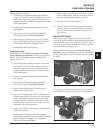
6.2
Section 6
Lubrication System
Figure 6-2. Oil Fill Cap/Dipstick.
4. Remove dipstick and check oil level. The level
should be between the FULL and ADD marks. If
low, add oil of the proper type up to the full
mark. Reinstall oil fill cap/dipstick and thread
tight.
Checking Oil Level
The importance of checking and maintaining the
proper oil level in the crankcase cannot be
overemphasized. Check oil BEFORE EACH USE as
follows:
1. Make sure the engine is stopped, level, and is cool
so the oil has had time to drain into the sump.
2. Clean the area around the oil fill cap/dipstick
before removing it. This will help to keep dirt,
grass clippings, etc., out of the engine.
3. Unthread and remove the oil fill cap/dipstick;
wipe oil off. Reinsert the dipstick into the tube
and rest the oil fill cap on the tube. Do not thread
the cap onto the tube. See Figure 6-2.
NOTE: To prevent extensive engine wear or damage,
always maintain the proper oil level in the
crankcase. Never operate the engine with the
oil level below the low mark or above the full
mark on the dipstick.
Changing Oil and Oil Filter
Changing Oil
Change the oil after every 100 hours of operation
(more frequently under severe conditions). Refill with
service class SG, SH, SJ or higher oil as specified in the
‘‘Viscosity Grades’’ table on page 6.1.
Change the oil while the engine is still warm. The oil
will flow more freely and carry away more
impurities. Make sure the engine is level when filling
or checking oil.
Figure 6-4. Oil Drain Plug (Starter Side).
Operating
Range
"Full" Mark
Figure 6-3. Oil Level Marks on Dipstick.
Figure 6-5. Oil Drain Plug (Oil Filter Side).
Oil Drain
Oil Drain
Oil Filter


















